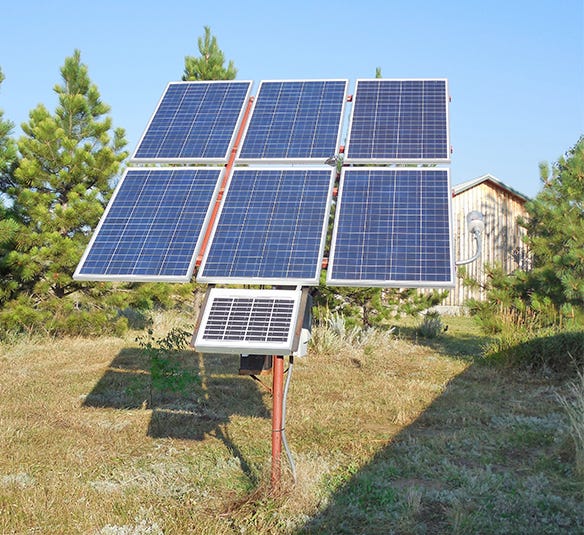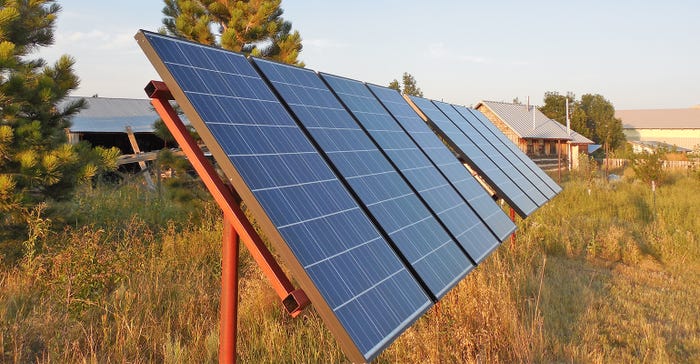August 28, 2018

Fifteen solar panels mounted on the roof of a pump house and another eight panels mounted on the ground produce a total of 2,300 watts of electricity during peak sunshine — and that’s enough power for Harold Stroh and his wife, Carla, on the High Plains of eastern Wyoming. It works because they keep energy conservation as a focus in their Niobrara County home.
The electricity from those panels flows to a bank of 16 six-volt, deep-cycle batteries wired series/parallel to produce a 12-volt battery bank.
In turn, an inverter takes the electricity out of the battery bank at 12 volts DC and inverts it to 110 volts AC, the standard house current.
“We have everything a normal house in the U.S. has except a dryer and dishwasher,” Stroh says. “Both use so much electricity that it becomes prohibitive.”

PUMPING WATER: A windmill on-site provides an additional way to pump water during prolonged periods of no sun. The pump is typically powered year-round by a six-panel solar system that produces up to 600 watts of electricity (shown).

A wind turbine provides backup power, especially during winter. It generates 1,000 watts of electricity when the wind is blowing pretty hard, which occurs often in windy Wyoming. The electricity is stored in the same 12-volt battery bank that the solar panels charge.
“I built the 8-foot prop myself, using some of the ideas of Hugh Piggott of Scotland, the mastermind behind the particular design I followed. The wind machine has been faultless,” says Stroh, who also built the wind turbine, did most of the work on the solar installation, and installed a submersible solar pump on the bottom of a well cylinder.
Concerning the 185-foot-deep well, he notes, six solar panels generate up to 600 watts of electricity, which in turn powers a pump that produces 5 gallons of water per minute. A 1,200-gallon cistern provides water for the home, horse and cattle corrals, vegetable garden and lawn.
“Once the cistern fills, the pump shuts off, so we’re not wasting electricity or water,” Stroh says.
He notes that ranchers and farmers wanting to install renewable energy can do much of the work themselves if they are willing to learn, or they can hire experts to help. Fortunately for Stroh, he has some background in electricity, and he also loves building things from the ground up.
“In high school, I worked in an electric shop rewinding electric motors and generators, a job that I found very fascinating,” he says.

SUN POWER: These eight solar panels provide up to 1,120 peak watts of electricity, which is stored in a battery room to help power the home.

Building a super-efficient home
Harold and Carla Stroh constructed a highly energy-efficient home in Wyoming, one of the key factors to successfully living off the grid.
But Harold Stroh says such building practices can also help ranchers and farmers retrofit an existing home, which will improve energy efficiency.
Additionally, he notes, if a new home is being planned, think energy conservation and sustainability, which could improve the bottom line over the long haul.
The design and construction follow a relatively new building approach termed “superinsulation,” which pays off in a climate like Niobrara County, which has an average low temperature of 10 degrees F in January and high temperatures into the 90s during July and August. The attic is insulated to nearly R-60, with 14 inches of blown-in cellulose, and the double-framed walls are insulated to R-50. This was achieved by building an exterior two-by-four wall sprayed with closed-cell urethane. An interior two-by-four wall, along with a 3-inch gap between the two walls, allowed an additional 6½ inches of fiberglass insulation.
Most of the windows in the house are on the south side. That allows solar gain in winter; during summer, however, carefully designed eaves keep out the sun.
All floors are thick Saltillo tile, which collects heat from the sun during winter; in summer, these same tile floors cool off at night, which, in turn, helps cool the house during the day. Texture on the walls is one-quarter-inch thick, which adds important thermal mass. Like the tile floors, the walls pick up solar gain during winter, but cool off during summer nights. During an August visit, the outside temp climbed to nearly 90 degrees F, but the house cooled down nicely the previous night and only heated up to a comfortable 69 degrees F during the day. This was achieved with building design and construction, not a central air conditioner.
Panels on the exterior of the house circulate antifreeze through a heat exchanger in an 8-by-11-foot indoor swimming pool. In turn, this heats the pool water, which helps warm the house during winter. A cover over the pool holds down humidity year-round, while a sliding door is kept closed in the hot months so heat doesn’t transfer throughout the house.
There are no windows on the north side of the house to buffer it from bitter cold winds and temperatures. Also on this side of the house are the pantry, mudroom and a second bathroom, which provide additional buffering from the main living area.
The only “traditional” heat in the home is provided by a very small woodstove in the basement, which circulates air up the stairwell and throughout the home. “We only burn one-and-a-half cords of wood all winter,” says Stroh, who would rather be working cattle and fine-tuning his grazing plan than cutting and hauling firewood.
“For me,” Stroh says, “this is a totally cool lifestyle.”
Waggener writes from Laramie, Wyo.
About the Author(s)
You May Also Like




